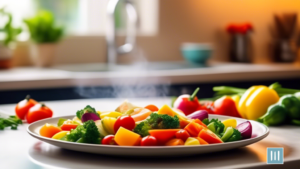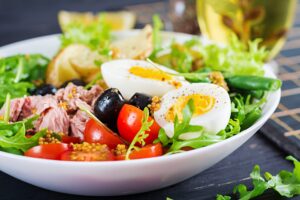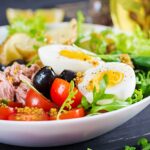Are you ready to embark on a culinary journey towards a healthier, happier you? Imagine your kitchen as a canvas, and each ingredient as a stroke of paint, creating a masterpiece of nutritious and delicious meals. The art of healthy cooking for weight loss is not just about shedding pounds, but about nourishing your body and soul.
By choosing nutrient-dense ingredients, incorporating whole foods, balancing macronutrients, experimenting with flavorful herbs and spices, and practicing mindful eating, you can create meals that not only help you reach your weight loss goals but also leave you feeling satisfied and energized.
As you explore the art of healthy cooking, remember that every meal you prepare is an opportunity to show love and care for yourself. By focusing on nourishing your body with wholesome ingredients and mindful eating practices, you are not only taking steps towards a healthier lifestyle but also setting an example for those around you.
Let your kitchen be a place of creativity and self-expression, where each dish you create is a reflection of your commitment to your well-being. So, grab your apron, sharpen your knives, and get ready to paint a picture of health and vitality with every meal you cook.
Key Takeaways
- Kitchen as a canvas for creating nutritious meals
- Importance of nourishing body and soul through healthy cooking
- Balancing macronutrients for weight loss
- Mindful eating practices for portion control
Choosing Nutrient-Dense Ingredients
To achieve weight loss through healthy cooking, you should focus on choosing ingredients that are both filling and low in calories, even if you might think they’re less flavorful than high-calorie options. Opt for nutrient-dense foods like leafy greens, lean proteins, and whole grains to create satisfying meals that won’t leave you feeling deprived.
By incorporating a variety of colorful fruits and vegetables into your dishes, you can boost your intake of essential vitamins and minerals while keeping your calorie count in check. When shopping for ingredients, pay attention to labels and choose whole, unprocessed foods whenever possible.
Avoid items with added sugars, unhealthy fats, and artificial ingredients that can sabotage your weight loss efforts. Instead, opt for natural, wholesome ingredients that will nourish your body and support your goals. Remember, healthy cooking isn’t about sacrificing flavor, but finding creative ways to enhance the taste of your meals using herbs, spices, and other natural seasonings.
Incorporating Whole Foods into Your Meals
Embrace whole foods as the foundation of your meals for better results in your weight loss journey. Whole foods, such as fruits, vegetables, whole grains, and lean proteins, offer a wealth of nutrients that your body craves. By incorporating these foods into your meals, you not only nourish your body but also sustainably support your weight loss goals.
Whole foods are nutrient-dense and provide essential vitamins and minerals that your body needs to function optimally. Whole foods are naturally lower in calories and higher in fiber, helping you feel full and satisfied without overeating. Whole foods are free from added sugars, unhealthy fats, and artificial ingredients, making them a clean and wholesome choice for your meals.
Make whole foods the star of your plate and watch as your body responds positively to the nourishment it receives. Prioritize these ingredients in your cooking, and you’ll be well on your way to achieving your weight loss goals while enjoying delicious and satisfying meals.
Balancing Macronutrients for Weight Loss
Achieving a balanced mix of proteins, carbohydrates, and fats is important for successful weight management. When preparing your meals, aim to include lean proteins like chicken, turkey, or tofu, healthy carbohydrates such as whole grains, fruits, and vegetables, and good fats like avocado, nuts, and olive oil.
These macronutrients work together to keep you feeling full, satisfied, and energized throughout the day, helping you stay on track with your weight loss goals. Remember, it’s not about depriving yourself or cutting out entire food groups. It’s about finding the right balance that works for your body and lifestyle.
By incorporating a variety of nutrient-dense foods in each meal, you’ll not only support your weight loss efforts but also nourish your body from the inside out. So, next time you’re in the kitchen, think about how you can create a well-rounded plate that includes all three macronutrients for a delicious and satisfying meal that supports your journey towards a healthier you.
Experimenting with Flavorful Herbs and Spices
Experiment with a variety of flavorful herbs and spices to add excitement to your meals and make your taste buds dance with joy. By infusing your dishes with a blend of aromatic seasonings, you can transform a simple meal into a culinary masterpiece that will leave you feeling satisfied and content.
Embrace the world of herbs and spices as your culinary playground, and let your creativity flow as you experiment with different combinations to enhance the flavors of your dishes.
- Discover the power of fresh herbs like basil, cilantro, and parsley to bring a burst of brightness to your meals.
- Dive into the world of warming spices such as cinnamon, cumin, and turmeric to add depth and complexity to your cooking.
- Don’t be afraid to mix and match different herbs and spices to create unique flavor profiles that will elevate your dishes to new heights.
With each sprinkle and dash, you’ll be one step closer to mastering the art of healthy cooking for weight loss while delighting your senses and nourishing your body with every bite.
Mindful Eating Practices for Portion Control
Practice mindful eating habits to help you control your portions and develop a healthier relationship with food. When you pay attention to what you eat and how much you eat, you become more in tune with your body’s hunger and fullness cues. This can prevent overeating and sustainably promote weight loss. Start by slowing down while eating, chewing your food thoroughly, and savoring each bite.
Here is a table to guide you on portion control:
| Food Group | Recommended Portion Size | Examples |
|---|---|---|
| Proteins | Palm-sized portion | Chicken breast, tofu |
| Carbohydrates | Fist-sized portion | Brown rice, quinoa |
| Vegetables | Two fist-sized portions | Broccoli, spinach |
Frequently Asked Questions
Can I still enjoy desserts and treats while following a healthy cooking plan for weight loss?
Craving something sweet while eating healthy? Don’t worry, you can have your cake and eat it too! With a little creativity, you can still enjoy delicious desserts and treats on your weight loss journey.
How can I stay motivated to cook healthy meals consistently?
To stay motivated to cook healthy meals consistently, remind yourself of the benefits like increased energy and improved well-being. Plan ahead, keep meals simple, and involve loved ones in the process for support and accountability.
Are there any specific cooking techniques that can help retain the nutrients in the ingredients?
To retain nutrients in your ingredients, try steaming, roasting, or sautéing instead of boiling. These methods help preserve vitamins and minerals. Remember, serving nutritious meals is an act of love for yourself and others.
How can I meal prep effectively to save time and stay on track with my weight loss goals?
To meal prep effectively, plan ahead by choosing simple recipes with fresh ingredients. Batch cook proteins, grains, and veggies for easy assembly. Use portion-controlled containers for grab-and-go meals that keep you on track with your goals.
Are there any specific kitchen tools or gadgets that can make healthy cooking easier and more efficient?
To make healthy cooking easier, invest in tools like a quality blender for smoothies, a vegetable spiralizer for low-carb noodles, and a digital food scale for accurate portions. These gadgets can streamline your meal prep process.














